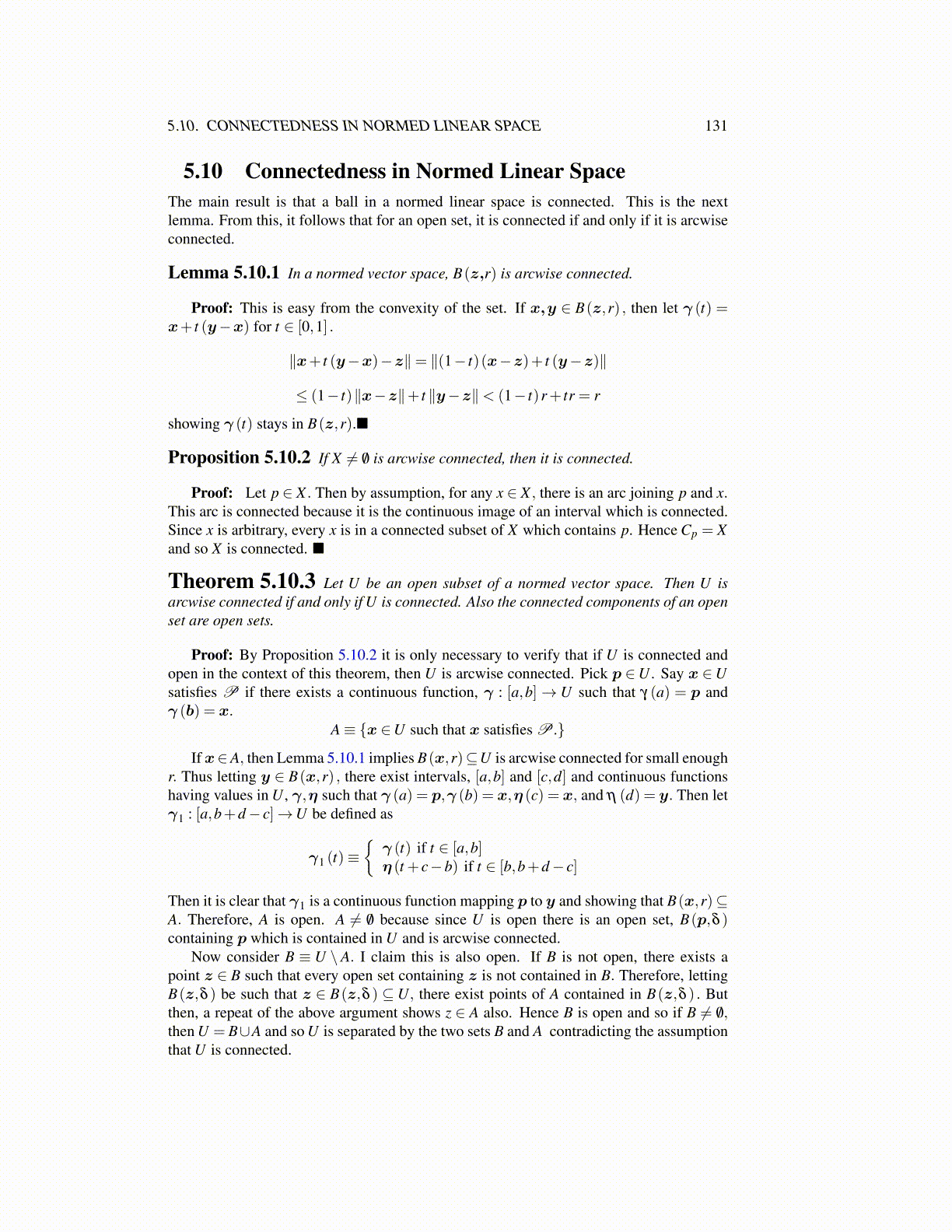
5.10. CONNECTEDNESS IN NORMED LINEAR SPACE 131
5.10 Connectedness in Normed Linear SpaceThe main result is that a ball in a normed linear space is connected. This is the nextlemma. From this, it follows that for an open set, it is connected if and only if it is arcwiseconnected.
Lemma 5.10.1 In a normed vector space, B(z,r) is arcwise connected.
Proof: This is easy from the convexity of the set. If x,y ∈ B(z,r) , then let γ (t) =x+ t (y−x) for t ∈ [0,1] .
∥x+ t (y−x)−z∥= ∥(1− t)(x−z)+ t (y−z)∥
≤ (1− t)∥x−z∥+ t ∥y−z∥< (1− t)r+ tr = r
showing γ (t) stays in B(z,r).■
Proposition 5.10.2 If X ̸= /0 is arcwise connected, then it is connected.
Proof: Let p ∈ X . Then by assumption, for any x ∈ X , there is an arc joining p and x.This arc is connected because it is the continuous image of an interval which is connected.Since x is arbitrary, every x is in a connected subset of X which contains p. Hence Cp = Xand so X is connected. ■
Theorem 5.10.3 Let U be an open subset of a normed vector space. Then U isarcwise connected if and only if U is connected. Also the connected components of an openset are open sets.
Proof: By Proposition 5.10.2 it is only necessary to verify that if U is connected andopen in the context of this theorem, then U is arcwise connected. Pick p ∈U . Say x ∈Usatisfies P if there exists a continuous function, γ : [a,b]→ U such that γ (a) = p andγ (b) = x.
A≡ {x ∈U such that x satisfies P .}
If x∈A, then Lemma 5.10.1 implies B(x,r)⊆U is arcwise connected for small enoughr. Thus letting y ∈ B(x,r) , there exist intervals, [a,b] and [c,d] and continuous functionshaving values in U , γ,η such that γ (a) = p,γ (b) = x,η (c) = x, and η (d) = y. Then letγ1 : [a,b+d− c]→U be defined as
γ1 (t)≡{
γ (t) if t ∈ [a,b]η (t + c−b) if t ∈ [b,b+d− c]
Then it is clear that γ1 is a continuous function mapping p to y and showing that B(x,r)⊆A. Therefore, A is open. A ̸= /0 because since U is open there is an open set, B(p,δ )containing p which is contained in U and is arcwise connected.
Now consider B ≡ U \A. I claim this is also open. If B is not open, there exists apoint z ∈ B such that every open set containing z is not contained in B. Therefore, lettingB(z,δ ) be such that z ∈ B(z,δ ) ⊆U, there exist points of A contained in B(z,δ ) . Butthen, a repeat of the above argument shows z ∈ A also. Hence B is open and so if B ̸= /0,then U = B∪A and so U is separated by the two sets B and A contradicting the assumptionthat U is connected.